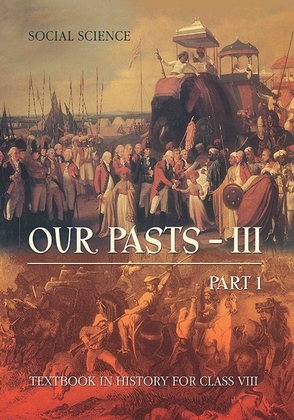Class 8 - Social Science - History (Our Pasts- III)
Chapter 5 - When People Rebel

Top Block 1
Question :1. What was the demand of Rani Lakshmibai of Jhansi that was refused by the British?
Answer :
Rani Lakshmibai of Jhansi wanted the East India Company to recognise her adopted son as the heir to the kingdom after the death of her husband. This demand was refused by the British. Ultimately, the Company annexed the kingdom as per the Doctrine of Lapse.
Question :2: What did the British do to protect the interests of those who converted to Christianity ?
Answer :
In 1850, a new law was passed to make conversion to Christianity easier. This law allowed an Indian who had converted to Christianity to inherit the property of his ancestors.
Question :3: What objections did the sepoys have to the new cartridges that they were asked to use?
Answer :
The new cartridges were suspected of being coated with the fat of cows and pigs. Both Hindus and Muslim sepoys were offended by the introduction of these cartridges. Their religious sentiments were affected, and this was the reason they refused to use the cartridges. They felt that the British were trying to insult their religions.
Question :4: How did the last Mughal emperor live the last years of his life?
Answer :
After the death of Aurangzeb, Mughal emperors held only symbolic value. Bahadur Shah Zafar was the last such Mughal emperor. During the 1857 revolt, the rebels needed someone who would rule the land once the British were thrown out of the country. They decided that this leader would have to be the Mughal emperor living in the Red Fort, in Delhi. Though a reluctant leader at first, Bahadur Shah did play an important role in the rebellion. Though Mughals had lost their earlier authority, a Mughal emperor’s word still held importance for quite a number of smaller rulers and chieftains. Bahadur Shah sent letters to all such chiefs and rulers, urging them to come forward and support the rebellion. After the revolt was suppressed, Bahadur Shah was tried in court and sentenced to life imprisonment. He and his wife were sent to prison in Rangoon in October 1858. He died in the Rangoon jail in November 1862.
Question :5: What could be the reasons for the confidence of the British rulers about their position in India before May 1857?
Answer :
Since the mid-eighteenth century, the power of the nawabs and rajas was on its decline. The presence of British Residents in the courts further eroded their authority and curtailed their freedom to administer their kingdoms. The various kingdoms were forced to disband their armies and enter into a subsidiary alliance with the British.
The terms of the subsidiary alliance, and later, of the Doctrine of Lapse were such that the East India Company slowly but surely took control over the kingdoms one by one. From 1757 to 1857, the Company successfully annexed various Indian states, virtually unopposed, by using a variety of political, economic and diplomatic methods. It rarely had to use military power. Another reason for the confidence of the British was the decline of the Mughal dynasty. The Company, through various measures, ensured that the dynasty came to an end. The name of the Mughal king was removed from the coins minted by the Company. It was also decided upon that Bahadur Shah would be the last Mughal king and after his death, none of his descendents would be recognised as kings. The fact that apart from the Company there was no other dominant authority in the Indian subcontinent, and the belief that there was absolutely no threat to its authority together contributed to its confidence about its position in India before May 1857. This is the reason why the revolt and the threatening form it took came as a shock to the British.
Question :6: What impact did Bahadur Shah Zafar’s support to the rebellion have on the people and the ruling families?
Answer :
Though the rebels were determined to bring the East India Company’s rule in country to an end, they were faced with the question as to who would rule the land once the space of power fell vacant. The answer to this question lay in Red Fort, in Delhi. That was where the aging Mughal emperor, Bahadur Shah Zafar had been residing. After the death of Aurangzeb, the Mughal dynasty had declined and many smaller power centres had begun asserting their authority. Yet, the word of the Mughal king still held force for quite a number of ruling families. Threatened by the expansion of the British rule, many of them felt that if the Mughal emperor could rule again, they too would be able to rule their own territories once more. When the rebel forces reached Red Fort, Bahadur Shah was reluctant at first to take on the might of the British. However, he had to give in, and was thus proclaimed their leader. Having this symbolic head inspired the rebels to fight the British with renewed confidence, hope and courage. The emperor wrote letters to the various chiefs and rulers of the country to come forward and organise a confederacy of Indian states to fight the British. In consequence of this action, the rebellion spread. The leadership of the Mughal emperor seemed to provide legitimacy to it. Regiment after regiment mutinied, and joined the rebel troops at Delhi, Kanpur and Lucknow. After them, the people of various Indian towns and villages also rose up in rebellion and rallied around local leaders, zamindars and chiefs. This not only strengthened the rebel forces, but also gave a national character to the rebellion.
Question :7: How did the British succeed in securing the submission of the rebel landowners of Awadh?
Answer :
During the revolt, the defeat of the British forces in a number of battles caused a number of uprisings against the British in various Indian states. A widespread popular rebellion developed in the region of Awadh in particular. The villages took to arms and the landlords led them. After the defeat of the rebel forces, the British had a two-pronged strategy to suppress the rebels and the rebellion. On the one hand, they tried and hanged a number of rebel leaders who had challenged their authority and could do so again in the future. On the other hand, they tried their best to win back the loyalty of the people. They announced reward for loyal landowners. They were assured that they would be allowed to continue to enjoy traditional rights over their lands. Those who had rebelled were told that if they submitted to the British, and if they had not killed any white people, they would remain safe and their rights and claims to land would not be denied.
Mddle block 1
Question :8: In what ways did the British change their policies as a result of the rebellion of 1857?
Answer :
Changes in the policies of the British after the suppression of the rebellion of 1857:
(i) British Crown took over the control of administration − The British Parliament passed an Act in 1859, under which, the powers of the East India Company were transferred to the British Crown. The British government was now directly responsible for ruling India.
(ii) Provided a sense of security to the local rulers − The ruling chiefs of the country were assured that their territories would never be annexed by the British. However, they had to swear allegiance to the British crown. They also abolished the Doctrine of Lapse, thereby allowing rulers to pass on their kingdoms to adopted sons.
(iii) Provided a sense of security to landowners − Policies were made to protect landlords and zamindars, and give them security of rights over their lands.
(iv) Reorganised the army − The proportion of Indian soldiers in the army was reduced and the number of European soldiers in the army was increased.
(v) Treated the Muslims with suspicion and hostility − Considering them to be responsible for the rebellion in a big way, the British confiscated the land and property of Muslims on a large scale.
(vi) Promised non-interference in the sphere of religion − The British assured the people of India that their religious and social practises would be respected and not interfered with.



